
The chlorarachniophytes are a small group of exclusively marine algae widely distributed in tropical and temperate waters. They are typically mixotrophic, ingesting bacteria and smaller protists as well as conducting photosynthesis. Normally they have the form of small amoebae, with branching cytoplasmic extensions that capture prey and connect the cells together, forming a net. They may also form flagellate zoospores, which characteristically have a single subapical flagellum that spirals backwards around the cell body, and walled coccoid cells.

The Cercozoa are a group of single-celled eukaryotes. They lack shared morphological characteristics at the microscopic level, being defined by molecular phylogenies of rRNA and actin or polyubiquitin. They are the natural predators of many species of microbacteria and Archea.

The Rhizaria are a species-rich supergroup of mostly unicellular eukaryotes. Except for the Chlorarachniophytes and three species in the genus Paulinella in the phylum Cercozoa, they are all non-photosynthethic, but many foraminifera and radiolaria have a symbiotic relationship with unicellular algae. A multicellular form, Guttulinopsis vulgaris, a cellular slime mold, has also been described. This supergroup was proposed by Cavalier-Smith in 2002. Being described mainly from rDNA sequences, they vary considerably in form, having no clear morphological distinctive characters (synapomorphies), but for the most part they are amoeboids with filose, reticulose, or microtubule-supported pseudopods. The Rhizaria’s pseudopodial mineral skeleton network, which is made up of opal (SiO₂), celestite (SrSO₄), or calcite (CaCO₃), is what differentiates it from the amoebae. It can attain sizes of more than a centimeter with some species being able to form cylindrical colonies approximately 1 cm in diameter and greater than 1 m in length. They feed by capturing and engulfing prey within the extensions of their pseudopodial skeletons, and some even become homes for algae, which aid in boosting the total primary production of the ocean.

The Labyrinthulomycetes (ICBN) or Labyrinthulea (ICZN) are a class of protists that produce a network of filaments or tubes, which serve as tracks for the cells to glide along and absorb nutrients for them. The two main groups are the labyrinthulids and thraustochytrids. They are mostly marine, commonly found as parasites on algae and seagrasses or as decomposers on dead plant material. They also include some parasites of marine invertebrates.

Microsporidia are a group of spore-forming unicellular parasites. They were once considered protozoans or protists, but are now known to be fungi, or a sister group to fungi. They have recently been discovered to infect Coleoptera on a large scale, in a 2017 Cornell study. Loosely 1500 of the probably more than one million species are named. Microsporidia are restricted to animal hosts, and all major groups of animals host microsporidia. Most infect insects, but they are also responsible for common diseases of crustaceans and fish. The named species of microsporidia usually infect one host species or a group of closely related taxa. Approximately 10 percent of the species are parasites of vertebrates —several species, most of which are opportunistic, can infect humans, in whom they can cause microsporidiosis.
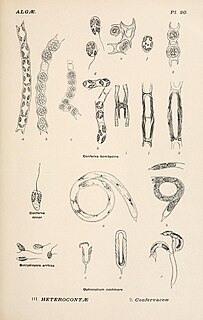
Yellow-green algae or the Xanthophyceae (xanthophytes) are an important group of heterokont algae. Most live in fresh water, but some are found in marine and soil habitats. They vary from single-celled flagellates to simple colonial and filamentous forms. Xanthophyte chloroplasts contain the photosynthetic pigments chlorophyll a, chlorophyll c, β-carotene, and the carotenoid diadinoxanthin. Unlike other heterokonts, their chloroplasts do not contain fucoxanthin, which accounts for their lighter colour. Their storage polysaccharide is chrysolaminarin. Xanthophyte cell walls are produced of cellulose and hemicellulose. They appear to be the closest relatives of the brown algae.

Cercomonads are small flagellates, widespread in aqueous habitats and common in soils.
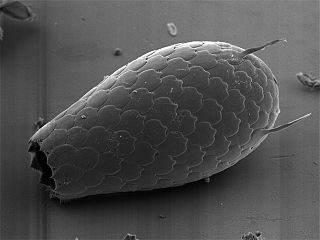
The euglyphids are a prominent group of filose amoebae that produce shells or tests from siliceous scales, plates, and sometimes spines. These elements are created within the cell and then assembled on its surface in a more or less regular arrangement, giving the test a textured appearance. There is a single opening for the long slender pseudopods, which capture food and pull the cell across the substrate.

The Phytomyxea are a class of parasites are cosmopolitan, obligate biotrophic protist parasites of plants, diatoms, oomycetes and brown algae. They are divided into the orders Plasmodiophorida and Phagomyxida.. Plasmodiophorids are best known as pathogens or vectors for viruses of arable crops.
Reticulosida is an order of Cercozoa that was created by Cavalier-Smith in 2003, but subsequently emended in by Bass et al. in 2009 to include only one monotypic family, the Filoretidae.
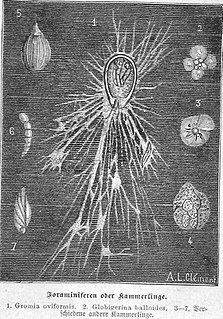
Gromiidea is a class of cercozoans.

The Archamoebae are a group of protists originally thought to have evolved before the acquisition of mitochondria by eukaryotes. They include genera that are internal parasites or commensals of animals. A few species are human pathogens, causing diseases such as amoebic dysentery. The other genera of archamoebae live in freshwater habitats and are unusual among amoebae in possessing flagella. Most have a single nucleus and flagellum, but the giant amoeba Pelomyxa has many of each.

Monadofilosa is a grouping of Cercozoa. These organisms are single-celled amoeboid protists.
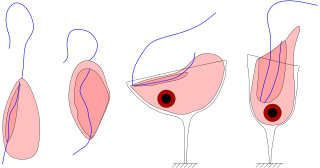
Jakobids are an order of free-living, heterotrophic, flagellar eukaryotes in the supergroup Excavata. They are small, and can be found in aerobic and anaerobic environments. The order Jakobida, believed to be monophyletic, consists of only twenty species at present, and was classified as a group in 1993. There is ongoing research into the mitochondrial genomes of jakobids, which are unusually large and bacteria-like, evidence that jakobids may be important to the evolutionary history of eukaryotes.
Phaeothamniophyceae is a class of heterokonts. It contains two orders, Phaeothamniales and Aurearenales, and consists of species separated from Chrysophyceae.

Colpodellida is an order of alveolate eukaryotes, which includes small predatory species such as Colpodella pugnax. They are active predatory flagellates that consume small protists. However they do not fully injest the prey, rather they absorb/“suck” the contents from the prey partially or fully. This method of “sucking” the contents from the prey is termed as mizocytosis.

Entomophthoromycota is a fungus division. In 2007, it was placed at the taxonomic rank of subphylum in the most recent revision of the entire fungus kingdom. In 2012, it was raised to the rank of phylum as "Entomophthoromycota" in a scientific paper by Richard A. Humber 2012. Divided into three classes and six families, it contains over 250 species that are mostly arthropod pathogens or soil- and litter-borne saprobes.

Cryptista is a clade of algae-like eukaryotes. It is sometimes placed along with Haptista in the group Hacrobia, within the kingdom Chromista. However, in 2016, a broad phylogenomic study found that cryptists fall within the group Archaeplastida, while haptophytes are closely related to the SAR supergroup.
Endohelea is a proposed clade of eukaryotes that are related to Archaeplastida and the SAR supergroup.
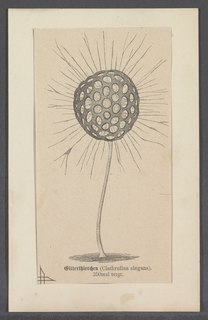
Granofilosea is a class of cercozoans in the subphylum Filosa.














